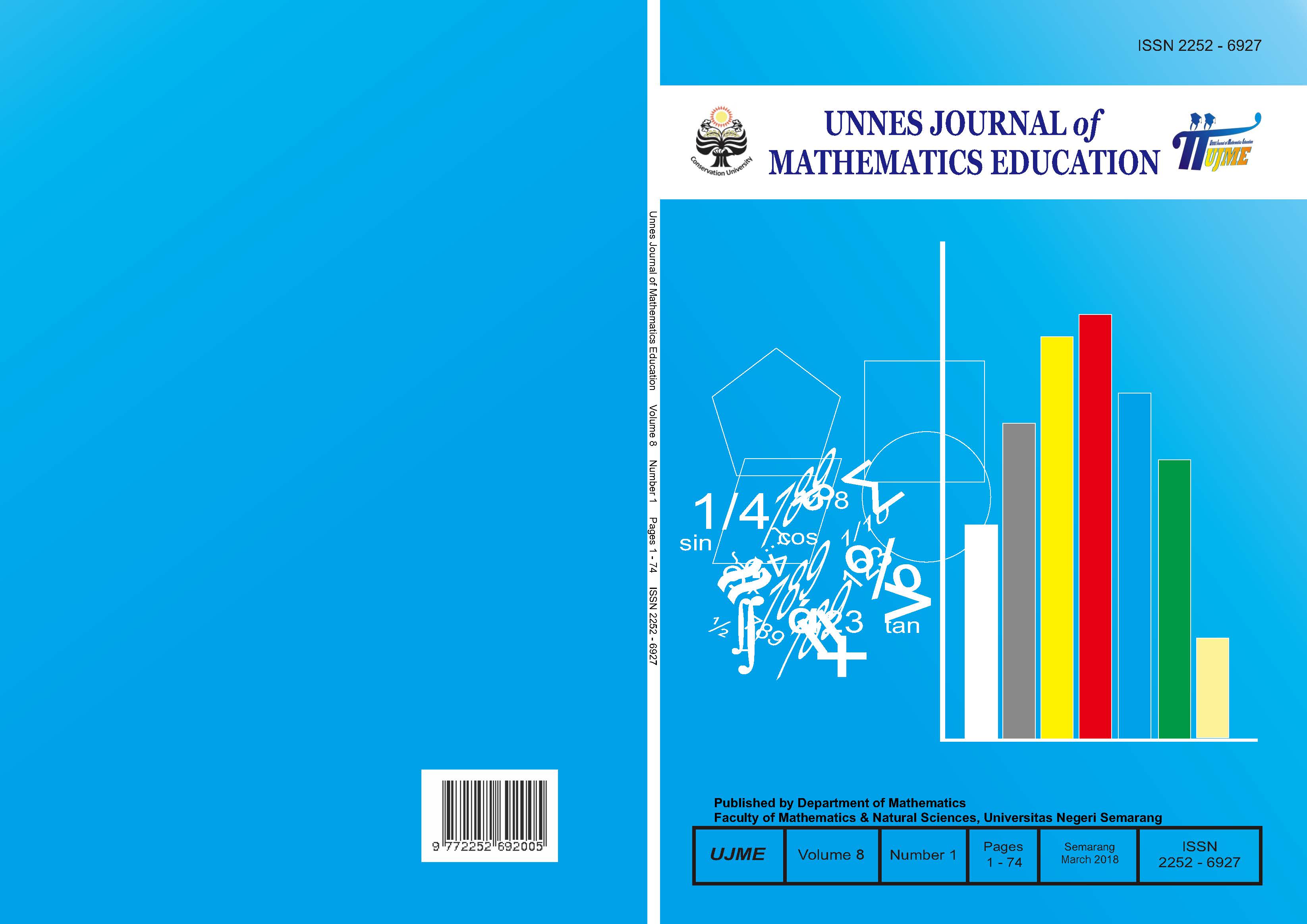An analysis of mathematical connection ability viewed from students’ questioning-skills through the educational tools in connected mathematics project learning model
##plugins.themes.academic_pro.article.main##
Abstract
This study aimed to determine the 7th grade students’ mathematical connections ability through CMP learning models to achieve learning mastery; to know whether the 7th grade students’ mathematical connections ability through CMP learning model was better than CMP learning model without educational tools; to know the student's questioning-skill factors; and to know the description of the ability of mathematical connections viewed from the 7th grade students' questioning-skills through the CMP learning model. The research method used was mixed method of the concurrent embedded model. The population in this research were all 7th-grade students of SMP Negeri 3 Semarang. The sample of research was taken from 7D and 7F classes. Subjects of this study were as many as 6 subjects with each of 2 subjects chosen from each category of questioning-skills. The results of the research showed that students' mathematical connection ability through the educational tools in CMP model learning achieved learning mastery; students' mathematical connection ability through CMP learning model was better than CMP learning model without the educational tools; the factors that influenced the students' questioning-skill were willingness within students, the use of educational tools, project-based learning/problem, and the response given by the teacher when students asked; and students' mathematical connection ability through CMP learning model viewed from questioning-skills indicated that students with high questioning-skill had best mathematical connection ability, followed by students with medium questioning-skill, and low questioning-skill.
##plugins.themes.academic_pro.article.details##
References
Hidayah, I & Sugiarto. 2014. The Implementation of Teacher Leadership in Mathematics Learning through A Series of Productive Questions. International Conference on Mathematics, Science, and Education. Unnes.
Hidayah, I. et al. 2016. The Role of Manipulatives Usage in Mathematics Learning of Primary Education with Scientific Approach Towards the Students’ Thingking Ability. IJABER. 4(10): 7215-7228.
Hendrian, H. et al. 2014. Mathematical Connection Ability and Self-Confidence. International Journal of Education. 8(1): 1-11
Kemendikbud. 2016. Materi Pelatihan Implementasi Kurikulum 2013. Jakarta: Kemendikbud.
Lestari, L.P. 2006. Keefektifan Pembelajaran dengan Penggunaan Alat Peraga dan Lembar Kerja Siswa (LKS) Terhadap Hasil Belajar Matematika dalam Pokok Bahasan Bangun Segiempat pada Siswa Kelas VII Semester 2 di SMP Muhammadiyah Margasari Kabupaten Tegal Tahun Pelajaran 2005/2006. Skripsi. Jurusan Matematika Universitas Negeri Semarang.
NCTM. 1989. Curriculum and Evaluation Standards for School Mathematics. Reston, VA: NCTM
_____. 2000. Principle and Standards for School Mathematics. The National Council of Teachers of Mathematics, Inc. 1906 Association Drive, Reston, VA 20191-9988. ISBN 0-87353-480-8. Tersedia di http://www.nctm.org/standards/ [diakses 19-11-2016].
Permendikbud No.58 Tahun 2014 tentang Kurikulum 2013 Sekolah Menengah Pertama/Madrasah Tsanawiyah.
Pranata, E. 2016. Implementasi Model Pembelajaran Group Investigation (GI) Berbantuan Alat Peraga untuk Meningkatkan Kemampuan Pemahaman Konsep Matematika. Jurnal Pendidikan Matematika Indonesia. 1(1): 34-38. p-ISSN: 2477-5967. e-ISSN: 2477-8443.
Rifa’i, A. & Anni, C.T. Pendidikan. Semarang:Universitas Negeri Semarang.
Rohaya, C. 2016. Upaya Peningkatan Hasil Belajar Matematika dengan Menggunakan Alat Peraga pada Siswa Kelas III Semester II SD Negeri 67 Pagaralam. JPPM: 9(2), 257-262.
Rohendi, D & Jojon, D. 2013. Connected Mathematics Project (CMP) Model Based on Presentation Media to the Mathematical Connection Ability of Junior High School Student. Journal of Education and Practice: 4(4): 17-22. p-ISSN: 2222-1735. e-ISSN: 2222-288X
Rosnawati, R. 2009. Berpikir Kritis melalui Pembelajaran Matematika untuk Mendukung Pembentukan Karakter Siswa. Seminar Nasional Pendidikan Universitas Sanata Dharma.
Royani, M & Muslim, B. 2014. Keterampilan Bertanya Siswa SMP Melalui Strategi Pembelajaran Aktif Tipe Team Quiz pada Materi Segi Empat. EDU-MAT Jurnal Pendidikan Matematika: 2(1), 22-28.
Rusmini & Surya, E. 2017. The Effect of Contextual Learning Approach to Mathematical Connection Ability and Student Self-Confidence Grade VIII SMP Negeri 8 Meda. International Journal of Sciences: Basic and Applied Research. 35(2): 249-262. ISSN 2307-4531.
Sa’adah. 2017. Penerapan Pendekatan Brain Based Learning Berbantuan Alat Peraga untuk Meningkatkan Kemampuan Koneksi Matematis Siswa SMP.
Saminanto & Kartono. 2015. Analysis of Mathematical Connection Ability in Linear Equation with One Variable Based on Connectivity Theory. International Journal of Education and Research. 3(4): 259-270.
Sugiarto & Hidayah, I. 2010. Petunjuk Penggunaan Alat Peraga Matematika. Semarang: Jurusan Matematika Unnes
Sugiarto. 2010. Petunjuk Pembuatan Alat Peraga Matematika. Semarang: Jurusan Matematika Unnes.
_______. 2013. Workshop Pendidikan Matematika I. Semarang: Jurusan Matematika Unnes.
Sugiyono. 2015. Metode Penelitian Pendidikan. Bandung: Alfabeta.
Suherman, et al. 2003. Strategi Pembelajaran Matematika Kontemporer. Bandung: JICA UPI.
Uno, H. B. 2010. Orientasi Baru dalam Psikologi Pembelajaran.Jakarta: PT Bumi Aksara.
